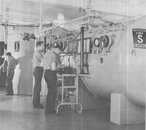David,
I was able to see a more recent study of fin efficiency, and found this quote:
http://archive.rubicon-foundation.org/xmlui/bitstream/handle/123456789/3936/12841609.pdf?sequence=1
This seems to confirm my work over these decades on the "scoop fin" concept.
SeaRat
I was able to see a more recent study of fin efficiency, and found this quote:
Here is the study:The Apollo fin possesses the lowest Froude efficiency, probably due to the split in the fin’s blade. The split allows water to “pass through” it instead of having the water pass over the surface to produce the desired pressure gradient between the attacking and leeward surfaces. The Apollo (Taped) and Quattro fins each have Froude efficiencies well above 60%. The common characteristic between these two configurations is that both have flanges along the lateral edges of the blade to direct flow to the fin tip which acts as dykes to channel the flow along the fin’s surface and ultimately being ejected from the TE.
http://archive.rubicon-foundation.org/xmlui/bitstream/handle/123456789/3936/12841609.pdf?sequence=1
This seems to confirm my work over these decades on the "scoop fin" concept.
SeaRat




